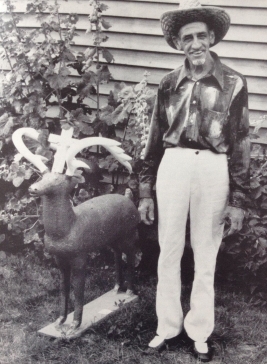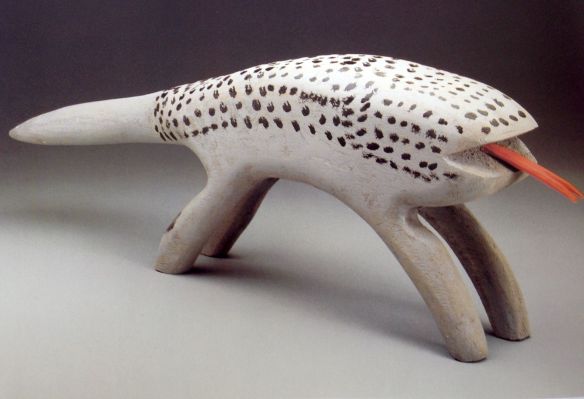
Billy in front of his cabin
Learning of the death of New York art dealer Phyllis Kind a couple of weeks ago got me to thinking about Billy Orr. I mentioned the exchange in a 2016 blog I wrote on Billy. Reproduced here:
“When I did the Outsider Art fair in New York City, I brought pictures of Bill’s place, along with many other examples of Canadian folk art, and showed them to the renowned art dealer, Phyllis Kind. She passed over much of what I showed her, but paused and really had a hard look at Billie’s work. She said “This is interesting. I’d like to know more about this artist.” When I got home I sent her photos, a bio, etc, and after a couple of weeks she phoned me to say that she would be interested if Bill would sell all of the work and she could show it as a reconstruction of Bill’s installation. Naturally she was concerned about the cost of moving all that concrete to New York. I got in touch with Bill but he wasn’t at all interested. I could tell that for him it would be like selling his family. Still, Phyllis is no slouch when it comes to art, and her interest reaffirmed my belief that Bill Orr was an exceptional individual and artist; and he was a lovely man to boot.”
 In retrospect, “no slouch when it comes to art” sounds a bit flippant, when I was meaning to suggest that “no slouch” is an understatement. I had and have great respect and admiration for her taste and instincts, and her contributions to the world of folk art. She was also very nice to me when I was a stranger in the midst of the dealers at the Outsider Art Fair in 1996.
In retrospect, “no slouch when it comes to art” sounds a bit flippant, when I was meaning to suggest that “no slouch” is an understatement. I had and have great respect and admiration for her taste and instincts, and her contributions to the world of folk art. She was also very nice to me when I was a stranger in the midst of the dealers at the Outsider Art Fair in 1996.
I remember seeing Phyllis Kind standing in a group of five or six other heavy- hitting art dealers in front of a Henry Darger painting in the booth of Carl Hammer. I couldn’t hear what they were saying, but I could tell that something heavy was going down. She was quite small and slight; in her sixties, wearing blue jeans and a punk rock, sleeveless black t-shirt, and holding her own in whatever they were talking about. I was struck that she had very thin and wrinkly arms, and I respected that she was strong enough and had the self- respect to put them out there. She was the epitome of cool. She had grace and presence.
Later that day, which was set up day, I was able to finish my work and have time to look at some of the other booths. I had brought a few dozen photos of work by Canadian folk artists in case there was some interest with the U.S. dealers. Mostly, there was not. Some of them were downright rude. But when I showed them to Phyllis Kind, after talking for an hour or so on various topics, she looked and passed on them all, but stopped when she came to Billy Orr. “Now this is interesting.”
She reacted immediately to the work, but became more interested when she heard Billie’s story and circumstances. The opening was drawing near so there was no more time to talk but she asked if I could come by her gallery the next day after the show. How great, I thought. Of course I will.
I haven’t had that many, but I have great fondness for those moments in my life where I say to myself, “how cool is this” “Here I am going into Phyllis Kind’s Soho gallery in New York city to show her pictures of Billy Orr’s zodiac sculptures.” I wish Billy were here.
Can you imagine? I flashed on Billy in his kitchen telling the mother raccoon who had walked through the front door that “she would have to wait for dinner as he had company”, and I imagined Billy standing next to me in the gallery talking to Kind, and I just tried to make note of everything around me, and everything that was said, and going on. Now twenty-two years on I remember some of it.
 Phyllis was interested in the fact that Billy had created his own “wooden” version of Stonehenge in his back forty, and that he occupied it with many Irish leprechauns, and zodiac figures he had created in cement. She imagined having all the work in her gallery, in a type of recreation of Billie’s world. We excitedly talked on about it a bit more, and we agreed that I would look into it when I got home in terms of interest on Billie’s part, and the logistics of getting all that cement to New York.
Phyllis was interested in the fact that Billy had created his own “wooden” version of Stonehenge in his back forty, and that he occupied it with many Irish leprechauns, and zodiac figures he had created in cement. She imagined having all the work in her gallery, in a type of recreation of Billie’s world. We excitedly talked on about it a bit more, and we agreed that I would look into it when I got home in terms of interest on Billie’s part, and the logistics of getting all that cement to New York.
I could tell that her interest was sincere, but I could also see a lot of reasons why it would probably just remain a lovely thought. Billy, predictably wasn’t the least bit interested, and of course the cost of getting all those heavy and fragile pieces to New York was prohibitive. The end.
Still. It is something to behold. Something that will live on in my head. Billy Orr shuffling up and muttering “hello” to Phyllis Kind at the opening of his solo exhibition in New York.


 Gilbert Desrochers was born on May 2, 1926, in Tiny Township. The fifth child in a family of six boys and one girl. His father Thomas owned a farm on the eighteenth concession, overlooking the bluffs of Thunder Bay Beach. He only attended school for two years when his mother died, and he went to work with his father and brothers on the family farm. “I wasn’t much good in school” he recalled. “I didn’t learn much. I went to school only to smoke. And I slept. I was always so tired that I fell asleep. I had no notion about school. I had only work in my head. I figured that work was easier than school.” Our father couldn’t read or write either and said “it’s just as well that you are like me. Come work with me in the woods.” “My father had two hundred sheep, and we took care of them. Also nine cows, three horses, chickens and pigs. In the winter we would cut wood all the time. We didn’t have a power saw so me and Joseph would cut wood all winter. It was a lot of work with cross-cut saws and Swede saws.
Gilbert Desrochers was born on May 2, 1926, in Tiny Township. The fifth child in a family of six boys and one girl. His father Thomas owned a farm on the eighteenth concession, overlooking the bluffs of Thunder Bay Beach. He only attended school for two years when his mother died, and he went to work with his father and brothers on the family farm. “I wasn’t much good in school” he recalled. “I didn’t learn much. I went to school only to smoke. And I slept. I was always so tired that I fell asleep. I had no notion about school. I had only work in my head. I figured that work was easier than school.” Our father couldn’t read or write either and said “it’s just as well that you are like me. Come work with me in the woods.” “My father had two hundred sheep, and we took care of them. Also nine cows, three horses, chickens and pigs. In the winter we would cut wood all the time. We didn’t have a power saw so me and Joseph would cut wood all winter. It was a lot of work with cross-cut saws and Swede saws.


